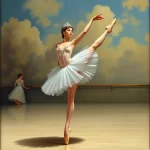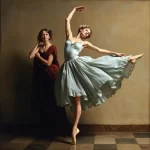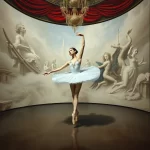British Ballet: The Legacy of The Royal Ballet

Introduction
Ballet, a classical dance form characterized by grace, precision, and elaborate formal gestures, has a rich history that spans several centuries and continents. Among the many countries that have contributed to the development and evolution of ballet, the United Kingdom holds a special place, primarily due to the influence of The Royal Ballet. The Royal Ballet has not only shaped the landscape of British ballet but has also left an indelible mark on the global ballet scene. This article delves into the legacy of The Royal Ballet, exploring its origins, development, unique characteristics, and lasting impact.
Origins of Ballet in the United Kingdom
Early Influences
The introduction of ballet to the United Kingdom can be traced back to the 17th century, during the reign of King Charles II. Having spent time in the French court, where ballet was flourishing under the patronage of Louis XIV, Charles II brought back with him a taste for this elegant art form. Early influences included the courtly dances of France and Italy, which were adapted and performed in the English courts. However, it wasn’t until the 20th century that ballet truly began to take root in British culture.
Key Figures
Several key figures were instrumental in establishing ballet in the United Kingdom. Among them, Dame Ninette de Valois stands out as a pioneering force. A former dancer with Sergei Diaghilev’s Ballets Russes, de Valois founded the Vic-Wells Ballet in 1931, which later became The Royal Ballet. Her vision and dedication laid the foundation for what would become one of the world’s leading ballet companies. Other notable figures include Sir Frederick Ashton, the company’s first choreographer, and Dame Margot Fonteyn, one of its most celebrated dancers.
Development and Evolution
Formative Years
The formative years of British ballet were marked by significant developments that helped shape its future. The establishment of the Vic-Wells Ballet School in 1926, which later became The Royal Ballet School, provided a formal training ground for young dancers. The company’s early performances, such as “Job” (1931) and “Checkmate” (1937), showcased a unique blend of classical technique and British theatricality. The appointment of Sir Frederick Ashton as the company’s first choreographer in 1935 brought a new level of artistic excellence, with works like “Symphonic Variations” (1946) and “Cinderella” (1948) becoming instant classics.
Cultural Integration
Ballet in the United Kingdom gradually integrated into the broader cultural landscape, gaining acceptance and admiration from society. The Royal Ballet’s performances at the Royal Opera House in Covent Garden became a cultural institution, attracting audiences from all walks of life. The company’s tours, both domestic and international, helped to further cement its reputation. Ballet also found its way into British cultural and political life, with royal patronage and state support playing crucial roles in its development.
Signature Style and Techniques
Unique Characteristics
British ballet is distinguished by its unique blend of classical technique and theatrical storytelling. The Royal Ballet, in particular, is known for its emphasis on narrative ballets, where the story is as important as the dance itself. This focus on storytelling is evident in works like “Romeo and Juliet” (1965) by Kenneth MacMillan and “The Sleeping Beauty” (1946) by Sir Frederick Ashton. The company’s style is also characterized by its musicality, attention to detail, and a certain understated elegance that sets it apart from other forms of ballet.
Influences on Global Ballet
The Royal Ballet’s influence on the global ballet scene cannot be overstated. Its repertoire, which includes both classical and contemporary works, has been performed by ballet companies around the world. Choreographers like Sir Frederick Ashton and Kenneth MacMillan have left a lasting legacy, with their works being staged by major ballet companies internationally. The Royal Ballet’s commitment to nurturing new talent and commissioning new works has also contributed to the evolution of ballet as a global art form.
Notable Ballet Companies and Schools
Major Ballet Institutions
The Royal Ballet and The Royal Ballet School are the two most significant institutions in British ballet. The Royal Ballet, based at the Royal Opera House in Covent Garden, is renowned for its diverse repertoire and exceptional dancers. The Royal Ballet School, located in Richmond Park and Covent Garden, provides world-class training to young dancers, many of whom go on to join The Royal Ballet or other prestigious companies. Other notable institutions include the English National Ballet and the Birmingham Royal Ballet, both of which have made significant contributions to the British ballet scene.
International Recognition
The Royal Ballet and its associated institutions have garnered numerous awards and accolades over the years. The company has received multiple Olivier Awards, including the Outstanding Achievement in Dance award. Dancers and choreographers associated with The Royal Ballet have also been recognized with prestigious honors, such as Dame Margot Fonteyn being made a Dame Commander of the Order of the British Empire (DBE) and Sir Frederick Ashton receiving a knighthood. The company’s international tours and collaborations have further solidified its reputation as a leading force in the world of ballet.
Iconic Ballet Performances and Choreographies
Signature Ballets
The Royal Ballet’s repertoire includes several iconic ballets that have become synonymous with the company. “The Sleeping Beauty,” choreographed by Sir Frederick Ashton, is a cornerstone of the company’s repertoire, known for its lavish production and technical demands. Kenneth MacMillan’s “Romeo and Juliet” is another signature piece, celebrated for its emotional depth and dramatic choreography. Other notable works include “Giselle,” “Swan Lake,” and “The Nutcracker,” each of which has been given a unique interpretation by The Royal Ballet.
Influential Choreographers
Several choreographers have left an indelible mark on The Royal Ballet and the broader ballet world. Sir Frederick Ashton, the company’s first choreographer, is known for his lyrical style and innovative use of classical technique. Kenneth MacMillan, who succeeded Ashton, brought a more dramatic and psychological approach to ballet, with works like “Manon” and “Mayerling” exploring complex themes and characters. More recently, choreographers like Wayne McGregor and Christopher Wheeldon have pushed the boundaries of contemporary ballet, creating works that blend classical and modern elements.
Contemporary Ballet in the United Kingdom
Modern Developments
In the contemporary era, British ballet continues to evolve, with new trends and innovations emerging. The Royal Ballet remains at the forefront, commissioning new works from leading choreographers and collaborating with artists from other disciplines. The company’s recent productions, such as Wayne McGregor’s “Woolf Works” and Christopher Wheeldon’s “Alice’s Adventures in Wonderland,” have received critical acclaim for their creativity and originality. The rise of digital technology has also opened up new possibilities for ballet, with live-streamed performances and virtual reality experiences bringing the art form to new audiences.
Current Challenges and Opportunities
Despite its many successes, the British ballet community faces several challenges. Funding cuts and economic pressures have made it difficult for some companies to sustain their operations. There is also an ongoing need to address issues of diversity and inclusion within the ballet world. However, these challenges also present opportunities for growth and innovation. Initiatives to make ballet more accessible and inclusive, such as outreach programs and scholarships, are helping to broaden the art form’s appeal. The continued support of patrons, audiences, and the government will be crucial in ensuring the future of British ballet.
Cultural Impact and Legacy
Cultural Significance
Ballet has had a profound impact on British culture, shaping and being shaped by the society in which it exists. The Royal Ballet’s performances are a cultural touchstone, attracting audiences from all walks of life and inspiring generations of dancers and choreographers. Ballet has also played a role in British cultural diplomacy, with international tours helping to promote the country’s artistic achievements on the global stage. The art form’s emphasis on discipline, creativity, and collaboration resonates with broader cultural values, making it an enduring and influential part of British life.
Global Influence
The legacy of British ballet extends far beyond the United Kingdom. The Royal Ballet’s repertoire and style have influenced ballet companies around the world, with many adopting its narrative approach and emphasis on musicality. British choreographers like Sir Frederick Ashton and Kenneth MacMillan have left a lasting mark on the global ballet scene, with their works being performed by major companies internationally. The Royal Ballet’s commitment to nurturing new talent and commissioning new works has also contributed to the evolution of ballet as a global art form, ensuring that its influence will continue to be felt for generations to come.
FAQ
What is the history of ballet in the United Kingdom?
Ballet was introduced to the United Kingdom in the 17th century, but it wasn’t until the 20th century that it truly began to flourish. Key figures like Dame Ninette de Valois and Sir Frederick Ashton played crucial roles in establishing The Royal Ballet, which has since become one of the world’s leading ballet companies.
Who are the most influential figures in British ballet?
Some of the most influential figures in British ballet include Dame Ninette de Valois, Sir Frederick Ashton, Dame Margot Fonteyn, and Kenneth MacMillan. More recent figures include Wayne McGregor and Christopher Wheeldon.
What makes British ballet unique?
British ballet is known for its unique blend of classical technique and theatrical storytelling. The Royal Ballet, in particular, emphasizes narrative ballets where the story is as important as the dance itself. The company’s style is also characterized by its musicality, attention to detail, and understated elegance.
How has the United Kingdom influenced global ballet?
The United Kingdom has had a significant influence on global ballet through The Royal Ballet’s repertoire and style. British choreographers like Sir Frederick Ashton and Kenneth MacMillan have left a lasting legacy, with their works being performed by major ballet companies internationally. The Royal Ballet’s commitment to nurturing new talent and commissioning new works has also contributed to the evolution of ballet as a global art form.
Are there any famous ballets from the United Kingdom?
Yes, several famous ballets have originated from the United Kingdom, including “The Sleeping Beauty” by Sir Frederick Ashton, “Romeo and Juliet” by Kenneth MacMillan, and more recent works like Wayne McGregor’s “Woolf Works” and Christopher Wheeldon’s “Alice’s Adventures in Wonderland.”
How can I learn more about ballet in the United Kingdom?
To learn more about ballet in the United Kingdom, you can explore books like “Ninette de Valois: Adventurous Traditionalist” by Richard Allen Cave and “Frederick Ashton and His Ballets” by David Vaughan. Documentaries such as “Margot” and “The Royal Ballet: The House” also provide valuable insights into the world of British ballet.
Conclusion
The legacy of The Royal Ballet is a testament to the enduring power and beauty of ballet as an art form. From its early beginnings under the visionary leadership of Dame Ninette de Valois to its current status as a global cultural institution, The Royal Ballet has played a pivotal role in shaping the landscape of British ballet. Its unique blend of classical technique and theatrical storytelling, combined with a commitment to artistic excellence and innovation, has left an indelible mark on the world of ballet. As we look to the future, the continued support and appreciation of this rich cultural tradition will ensure that British ballet remains a vibrant and influential force on the global stage.





